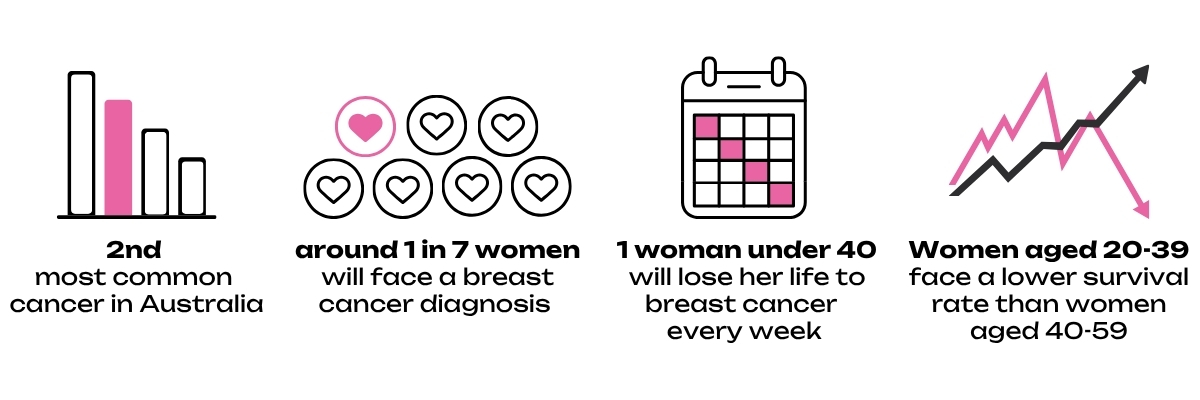
Your donation will help fund an innovative project aimed to improve immunotherapy for breast cancer.
 Len just donated $670
Len just donated $670 barry just donated $84.40
barry just donated $84.40 Callan just donated $5.28
Callan just donated $5.28 Kathleen just donated $158.25
Kathleen just donated $158.25 Jeremy just donated $79.13
Jeremy just donated $79.13 Sandy just donated $52.75
Sandy just donated $52.75 Beverley just donated $158.25
Beverley just donated $158.25 Gitanjali just donated $263.75
Gitanjali just donated $263.75 Margaret just donated $105.50
Margaret just donated $105.50 Hylin just donated $16.80
Hylin just donated $16.80 Heidi and David just donated $105.50
Heidi and David just donated $105.50 Len just donated $26.38
Len just donated $26.38 Anonymous just donated $105.50
Anonymous just donated $105.50 Vivian just donated $21.10
Vivian just donated $21.10 Jan just donated $1,020
Jan just donated $1,020 george just donated $1.06
george just donated $1.06 Peter just donated $263.75
Peter just donated $263.75 Alexandra just donated $73.85
Alexandra just donated $73.85 Tecia just donated $10
Tecia just donated $10 Robert just donated $200
Robert just donated $200
Breast cancer in Australia

Young women like Nicole are at higher risk of the deadliest breast cancers

“I was 33 and I went through medically induced menopause. My mum hadn't even gone through it yet.”
Despite having no symptoms besides feeling run down, Nicole was diagnosed with triple negative breast cancer. She had 3 tumours in her breasts, and the cancer had spread to her lymph nodes. She underwent months of chemo, surgery and radiation treatments that were so aggressive that she went into cardiac arrest.
Many don’t realise that young people can also be diagnosed with breast cancer, often with a lower chance of survival compared to older patients. Triple negative breast cancer, which is particularly fatal, is notorious for affecting women and people assigned female at birth under 50.
Nicole is now in remission and thriving in life. "It makes me smile today hearing about how much treatments have improved, and the significant impact of funds raised for cancer research." Her heartfelt wish is for other women to be spared the severe mental and physical toll of cancer treatment that she endured.
Make Nicole’s wish a reality by funding the vital research needed to develop better, less debilitating treatments for triple negative breast cancer.
Your gift can help women survive
triple negative breast cancer
Triple negative breast cancer (TNBC) is often considered the deadliest breast cancer as it grows and spreads quickly, is difficult to treat, and likely to return after treatment.
Dr Kellie Mouchemore from the Olivia Newton-John Cancer Research Institute is on a mission to change this through her tumour-mapping research project aimed at improving precision immunotherapy, which can be life-changing for high-risk TNBC patients with limited options.
But Kellie can’t do this without your support. Her project involves using state-of-the-art technology to map up to 500 genes in each cell of breast tumour samples—an endeavour that requires essential funding to get underway.
Your donation will directly support Kellie’s vital research by enabling her to identify new biomarkers that will predict which TNBC patients are unlikely to respond to immunotherapy. Kellie can then look for existing treatments that she can repurpose for these patients, and test them in combination with immunotherapy to improve their treatment options and survival.
By helping to raise $100,000 to fund a year of Kellie’s research project, you can provide the necessary resources to conduct this groundbreaking study. Your generosity makes it possible for this important research to move forward and potentially transform the lives of TNBC patients who urgently need better treatments.

“I am driven by the hope that one day the women in my life won’t have to live with so much anxiety around their risk or diagnosis.”
- Dr Kellie Mouchemore
How your donation helps

$75
Can help fund an hour of research

$125
Can help fund microscopy imaging to look for immune cells in tumours

$550
Can help provide lab supplies for up to 10 vital experiments

$1,000
Can help provide cutting-edge software to analyse cells
Our breast cancer stories

Triple negative breast cancer: Nicole's life-changing journey

It takes a village: Katrina's metastatic breast cancer story

What you need to know about breast cancer: prevention, detection and next steps
Our breast cancer researchers
Thank you to our supporters
Susan Hayman
Anonymous
My grandmother died of breast cancer a couple of years ago. I've had other family and friends with it too. There is a chance it runs in my family, so in the future I may be at risk. More than anything I would love to see effective treatments for even the deadliest of breastfeeding cancers available, not just potentially for myself but for all who may have to deal with this awful illness in the future. Women's health never gets the attention, funding or research it desperately needs, which contributes to women's suffering and death. Anyone working hard to bring an end and a cure to breast cancer is definitely doing something worthwhile. Thank you.
Rita Maria Naumann
Anonymous
Frequently Asked Questions
What is breast cancer?
Breast cancer occurs when abnormal cells in the breast grow in an uncontrolled way and can start in the ducts or the lobules (milk sacks) of the breast. Cancer that remains in the ducts or lobules is called non-invasive breast cancer. If the cancer spreads, it becomes invasive cancer.
Breast cancer is not sex-specific but is far more common in people assigned female at birth. It is estimated that in 2022, 20,640 new cases of breast cancer were diagnosed (including 212 diagnoses in people assigned male at birth), making it the second commonly diagnosed cancer in Australia.
Factors that increase the risk of breast cancer include increasing age, family history, inheritance of mutations in the genes BRCA2, BRCA1 and CHEK2, and/or a menstrual cycle that began before the age of 12.
What are the types of breast cancer?
Ductal carcinoma is the most common type of breast cancer. This type of cancer forms in the lining of a milk duct within your breast. Ductal carcinoma can remain within the ducts (ductal carcinoma in situ), or it can break out of the ducts (invasive ductal carcinoma)
Triple negative breast cancer (TNBC) is an aggressive cancer with a poor prognosis that is notorious for affecting younger women under 50 years. It lacks the 3 features commonly found on breast cancer cells (oestrogen, progesterone and HER2 receptors), which are typically targeted during breast cancer treatment.
Lobular carcinoma in situ (LCIS) is a non-invasive breast cancer that stays within the lobules of the breast, where breast milk is produced. When it breaks out of the lobules, it's considered invasive lobular carcinoma. The lobules are connected to the ducts, which carry breast milk to the nipple.
Metastatic breast cancer (also called advanced breast cancer) is an invasive breast cancer that has spread from the breast to other parts of the body.
What are the common signs and symptoms of breast cancer?
- A lump or the sensation of lumpiness
- A change in size or shape of the breast
- Any changes to the nipple, including crusting, redness, inversion, or discharge
- Redness or dimpling of the skin on the breast
- Persistent pain in or around the breast
It is widely recommended to do a breast self-exam monthly, ideally a few days after your period ends if you still menstruate. You can find out more here.
How is breast cancer diagnosed?
If you have any signs and symptoms, please see your GP. They will first perform a physical examination to check for any visible irregularities in your breasts. They may also ask about your medical history and any family history of breast cancer.
If necessary, the GP can then refer you for a mammogram, which may be followed by an ultrasound.
If breast cancer is suspected, some of the breast tissue will be removed and sent to a lab for examination. If cancer is detected, you may have additional scans to see if the cancer has spread to other parts of your body.
How does breast cancer screening work?
Breast cancer screening is a vital, life-saving tool for detecting breast cancer at an early stage, when there are no signs or symptoms. The screening involves a mammogram, a type of low-dose x-ray that can detect changes which may be too small to be felt during a physical examination.
BreastScreen Australia is the national breast cancer screening program, which is available in each state and territory.
People assigned female at birth who are aged between 50-74 and have no breast cancer symptoms are encouraged to participate in a free breast cancer screening every 2 years. This is because the biggest risk factors for developing breast cancer are being assigned female at birth and increasing age.
People assigned female at birth aged between 40-49 years and aged 75 and over who have no breast cancer symptoms are also eligible for a free breast cancer screening every 2 years.
For more information, you can head to Cure Cancer's breast cancer screening and prevention resource here. You can also visit the BreastScreen Australia website and contact them on 13 20 50.
What is the prognosis for breast cancer?
Breast cancer is usually graded in stages from 1-4. Early breast cancer is stage 1 or 2. The cancer is contained in the breast and may or may not have spread to lymph nodes in the armpit.
Locally advanced breast cancer is stage 3. The cancer is larger than 5 cm, has spread to tissues around the breast, or has spread to a large number of lymph nodes.
Metastatic breast cancer is stage 4. This means breast cancer has spread to other parts of the body. It is also called secondary or advanced breast cancer.
A prognosis will depend on the stage and grade of the cancer. The lower the grade, the better the prognosis. The survival rate for people with breast cancer has increased significantly over time as a direct result of research. Breast cancer now has one of the highest 5-year survival rates when diagnosed early.
Together, we can cure cancer.
Let's stay in touch
To receive updates on our work, campaigns and our impact in cancer research, subscribe to our newsletter.







